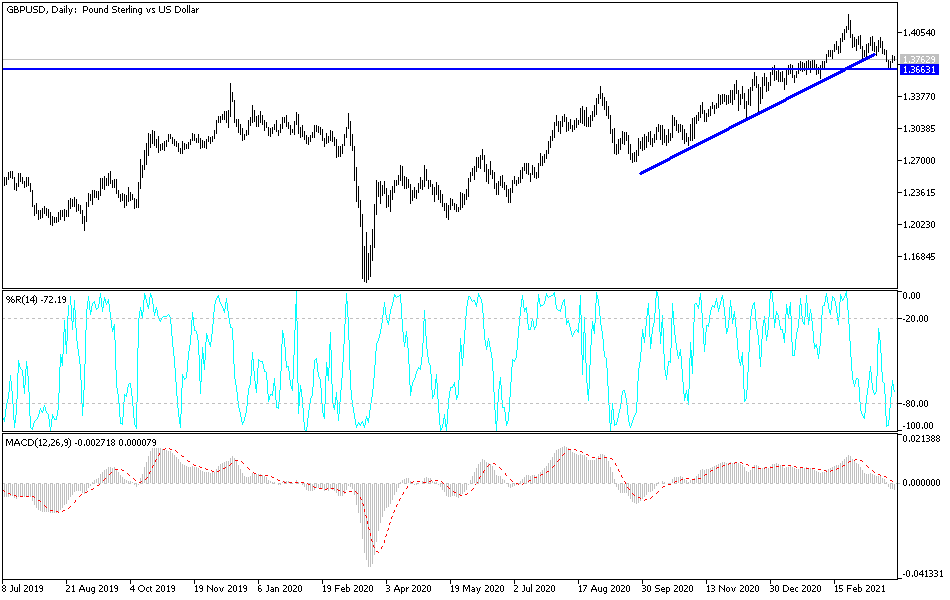Profit-taking in the GBP/USD pushed the pair to the support level at 1.3670, a near 2-month low. By the end of last week's trading, the pair tried to rebound higher, but its gains did not exceed the 1.3811 resistance level before closing trading around the 1.3790 level. Stimulus plans, the vaccination race against the coronavirus and the recovery from the effects of the pandemic are the reasons why investors are buying the dollar again. In addition, the European dispute over the amount of production and obtaining more vaccinations has been a pressure factor on the British pound recently.
The figures released by the European Union recently show that it is seeking to justify its actions, which could prohibit the export of the vaccine, showing that it has exported more vaccines than it has provided. Of the 77 million vaccines, about 21 million vaccines have been exported to the UK, which represents about two-thirds of the vaccines it has provided. While the United Kingdom has been among the most successful countries in introducing the vaccine, it has relied on European Union manufacturing capacity and its liberal export policy.
Accordingly, the European Union wants to be able to prevent further exports of the vaccine from companies that do not fulfill their domestic obligations, especially if the doses will go to countries that do not send full doses or vaccine components to the European Union or in a better condition. Separately, the European Union revealed that 100 million vaccines were delivered in the first quarter and more than three times are expected to be delivered in the second quarter.
Britain is taking another small step out of the lockdown as it looks with concern at the increase in cases of variants of the coronavirus and the flooding of its European neighbors. With vaccination rates against the virus in the United Kingdom exceeding those in the European Union, Prime Minister Boris Johnson is relieving the stark "stay at home" message that has reduced daily life - and kept the virus under control - for nearly three months.
Starting Monday, people will be allowed to meet in groups of six in the open air and can resume outdoor sports such as basketball, tennis and golf. The other parts of the United Kingdom - Scotland, Wales and Northern Ireland - are taking largely similar steps. In Wales, thousands of people flocked to beaches and beauty spots on Saturday, after authorities lifted travel restrictions imposed since December. Stephen Boyce, the medical director of the National Health Service in England, urged people to continue to follow the rules and limit contact with others, saying that loosening "does not mean getting the job done".
The draconian restrictions on business and social life during three lockdowns last year have garnered broad popular support, although they have alarmed some lawmakers in Johnson's Conservative Party, who argue that the economic, democratic and human costs outweigh the benefits. Most non-essential businesses remain closed, along with bars, restaurants, gyms, cinemas, theaters, museums and sports stadiums. Millions of workers were sacked, and the government paid the bulk of their wages.
The UK has recorded more than 126,000 deaths from COVID-19, the highest in Europe.
While many European countries are witnessing a new increase in the spread of the epidemic, Britain is relying on a rapid mass vaccination program to help it end the lockdown. Nearly 30 million people, or 56% of all adults, have received their first dose of the vaccine so far. Under the government's "roadmap" to lift the lockdown, shops, hairdressers and outdoor dining are scheduled to reopen in England on April 12, followed by closed spaces on May 17.
In this regard, Anthony Harenden, Vice Chair of the British Joint Committee on Immunization and Vaccination, said it is imperative that people who have received vaccinations remain vigilant.
US monetary policy officials remained optimistic about providing more economic stimulus and positive developments on the sectors of the US economy in response to those plans, which contributed strongly to the recent gains in the dollar.
Technical analysis of the pair:
On the daily chart, the GBP/USD is still in the range of its recently formed descending channel, and I see that there will be no exit from that channel without breaching the 1.4000 psychological resistance again. On the downside, a breach of the support at 1.3700 will increase the control of the bears, thus moving towards stronger support levels, the closest of which are currently 1.3660, 1.3580 and 1.3490. The second and third levels are better for buying because they will push the technical indicators to strong oversold levels. Still, I would prefer to buy the pair on every dip.
From Britain, the money supply, mortgage approvals and net lending to individuals will be announced. There is no significant US economic data available today.


